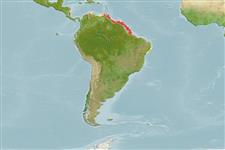Elasmobranchii (haaien en roggen) (sharks and rays) >
Myliobatiformes (Stingrays) >
Urotrygonidae (American round stingrays)
Etymology: Urotrygon: Greek, oura = tail + Greek, trygon = a sting ray (Ref. 45335).
Environment: milieu / climate zone / depth range / distribution range
Ecologie
marien demersaal; diepte 9 - 55 m (Ref. 58018). Tropical
Western Atlantic: Venezuela and the mouth of the Amazon.
Lengte bij maturiteit / Grootte / Gewicht / Leeftijd
Maturity: Lm 19.9, range 17 - ? cm
Max length : 11.8 cm WD mannelijk / geslacht onbekend; (Ref. 13608)
Korte beschrijving
Morfologie | Morfometrie
Long and pointed snout. Disc angular in front and naked. Tail longer, pectorals are angular and caudal fin narrower. Upper surface gray and lower surface whitish (Ref. 6902).
Levenscyclus en paargedrag
Maturiteit | Voortplanting | Paaien | Eieren | Fecunditeit | Larven
Uyeno, T., K. Matsuura and E. Fujii (eds.), 1983. Fishes trawled off Suriname and French Guiana. Japan Marine Fishery Resource Research Center, Tokyo, Japan. 519 p. (Ref. 13608)
Status op de Rode Lijst van het IUCN (Ref. 130435)
Gevaar voor de mens
Harmless
Gebruik door de mens
Meer informatie
ReferentiesAquacultuurAquacultuurprofielKweeklijnenGeneticaElectrophoresesErfelijkheidZiektesVerwerkingNutrientsMassaconversie
Tools
Speciale rapporten
Download XML
Internetbronnen
Estimates based on models
Preferred temperature (Ref.
123201): 26.7 - 28.1, mean 27.5 °C (based on 62 cells).
Fylogenetische diversiteitsindex (Ref.
82804): PD
50 = 0.5001 [Uniqueness, from 0.5 = low to 2.0 = high].
Bayesian length-weight: a=0.01413 (0.00575 - 0.03468), b=3.07 (2.86 - 3.28), in cm total length, based on LWR estimates for this (Sub)family-body shape (Ref.
93245).
Trofisch niveau (Ref.
69278): 3.7 ±0.6 se; based on size and trophs of closest relatives
Weerstandsvermogen (Ref.
120179): laag, minimale populatieverdubbelingstijd 4,5-14 jaar (Assuming fecundity<100).
Fishing Vulnerability (Ref.
59153): Low to moderate vulnerability (26 of 100).
